The Cultural Phenomenon of Tiki Bars: Tracing Polynesian Pop’s Rise in American Society
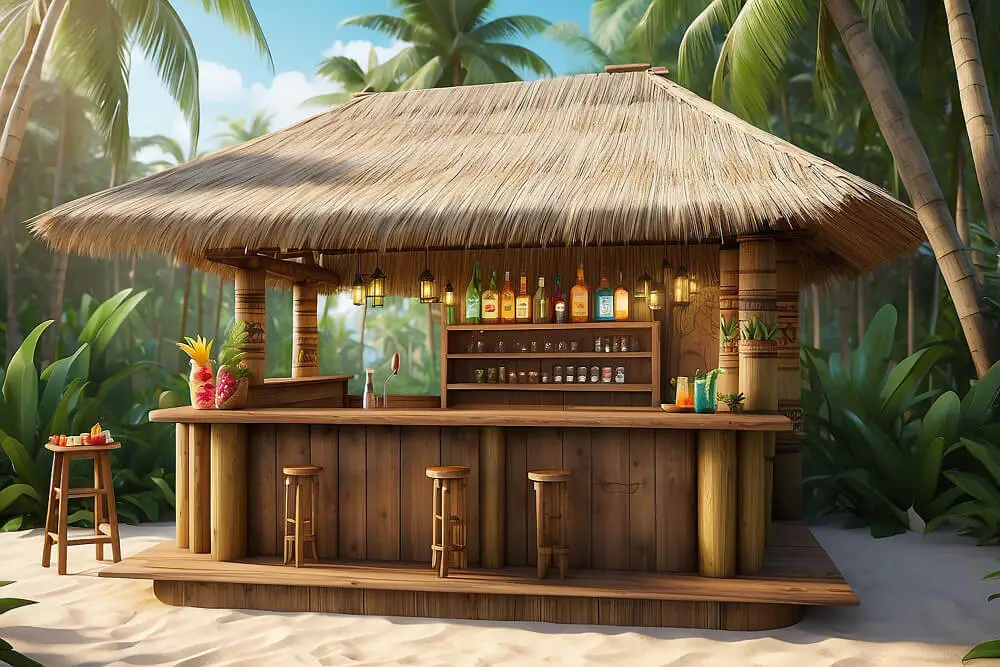
Updated On: April 24, 2024 by Yasmin Elwan
Tiki bars emerged as a distinctive part of the American cultural landscape, offering an exotic escape through Polynesian-inspired decor, food, and drink. These establishments began surfacing in the United States in the mid-20th century, a testament to the era’s fascination with tropical paradises. The stylised interpretation of Polynesian aesthetics, known as Polynesian Pop or Tiki culture, reflects a period when Americans were eager for an idealised version of the South Seas, marked by its signature thatched roofs, bamboo accents, and vibrant cocktail presentations.
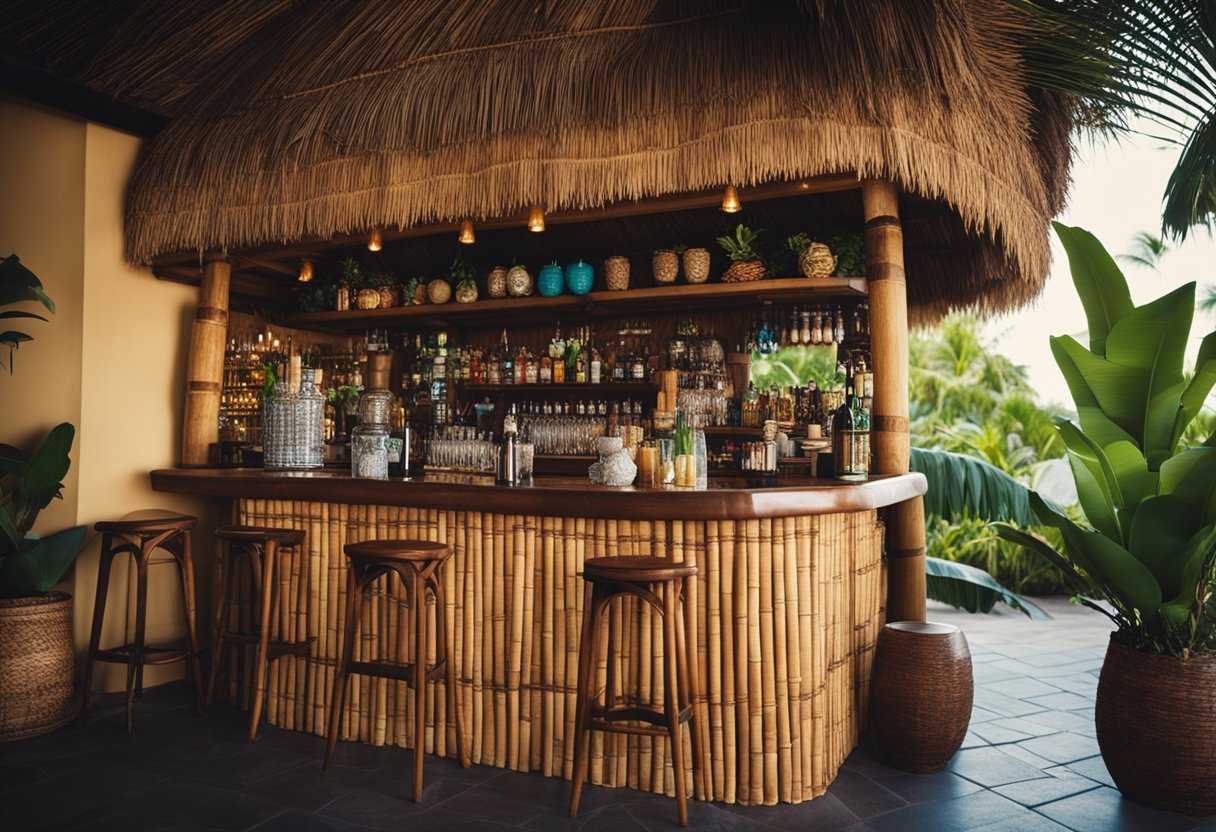
Encapsulating a unique blend of imagination and escapism, Tiki bars became a space where patrons could momentarily step out of their daily routines. The design and aesthetics of these venues drew on a variety of Polynesian motifs, blending elements from various cultures to create a fantasy setting. While Tiki bars reached their peak popularity in America during the 1950s and 1960s, they also represent a complicated chapter in cultural history, intertwining issues of appropriation with their impact on design and leisure. The phenomenon of Tiki bars continues to be revisited and reimagined, contributing to the discourse on cultural exchange and the evolution of social spaces.
Origins of Tiki Culture
In this section, we explore the inception of tiki culture in America, tracing its roots to the early 20th century and mapping the rise of its distinct style and ethos. We’ll touch upon its key establishments and the visionaries behind them.
The Birth of the Tiki Bar
Tiki bars made their grand entrance onto the American social scene at the end of Prohibition in the 1930s. These exotic venues were inspired by the allure of the South Pacific, specifically Polynesia, which had captivated the American imagination through travel and adventure stories. The first tiki bar, named Don the Beachcomber, opened in Hollywood and was adorned with tropical décor, summoning the spirit of island escapism within its walls.
Key Figures: Donn Beach and Victor Bergeron
Donn Beach, originally known as Ernest Raymond Beaumont Gantt, is considered the father of the tiki bar experience. His original establishment, Don the Beachcomber, laid the groundwork for what would become a widespread cultural phenomenon. On the other side, Trader Vic, or Victor Bergeron, became a prominent name after he transformed his eatery into a Polynesian-themed restaurant known as Trader Vic’s, further cementing the tiki bar’s place in American culture. These two individuals were pivotal in growing the tiki movement, each infusing their bars with their unique interpretations of Polynesian motifs.
Design and Aesthetics
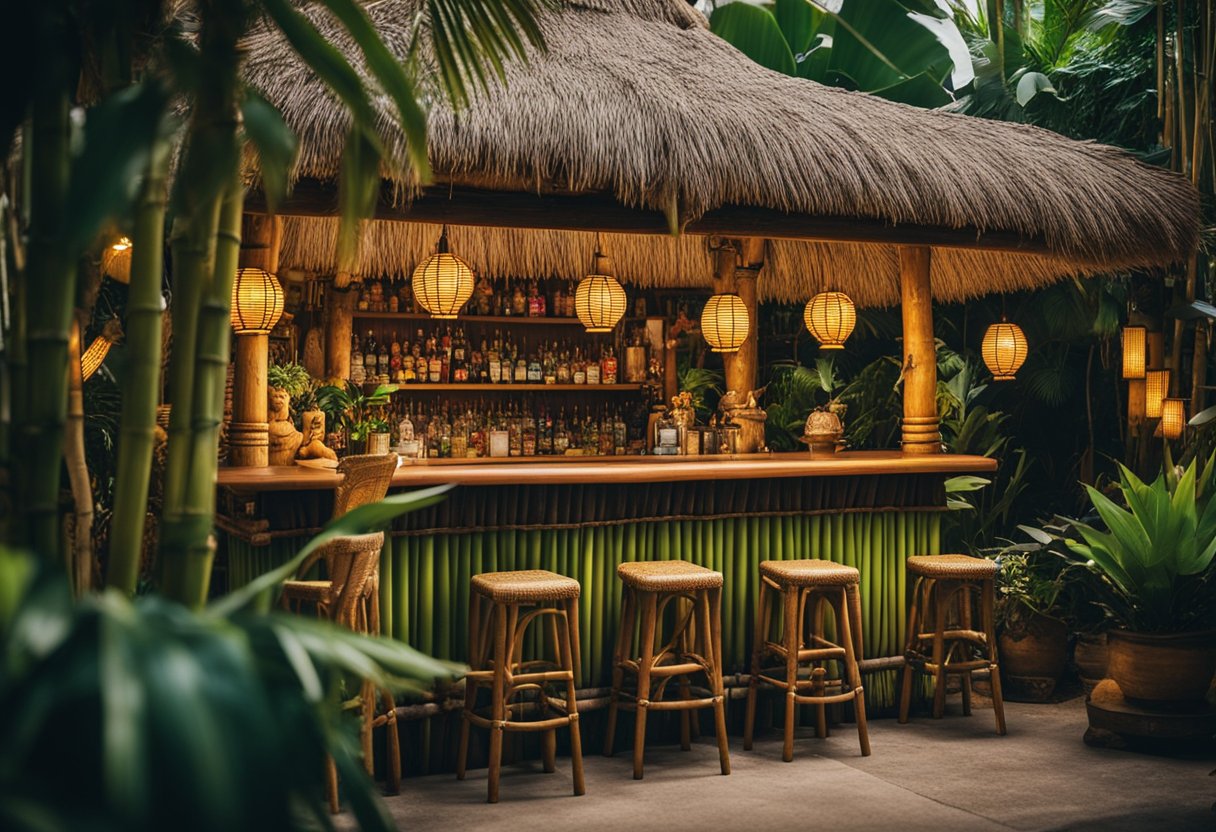
In our exploration of Tiki bars, the distinct design and aesthetics are pivotal, embodying a unique blend of exotic decor and vivid Polynesian-inspired elements that define this cultural phenomenon.
Exotic Decor and Architecture
We find that bamboo and rattan furniture often serve as the cornerstone of Tiki bar design, bringing a tactile element of the tropics to these themed establishments. The use of these materials in bars and lounges creates an ambience reminiscent of a Polynesian paradise. Architecturally, Tiki bars may feature thatched roofs and torches, fostering a sense of escapism where patrons can imagine themselves on an island retreat.
Iconography and Symbolism
Prominent within the Tiki bar scene is kitsch, an aspect characterised by playfully gaudy and humorous items which contribute to the overall whimsical atmosphere. Amongst the icons, Tiki statues stand tall, often carved with intricate details that add a layer of authentic Polynesian-style allure. These figures are not only decorative but also hold symbolic significance, harkening back to the South Pacific cultures that inspire Tiki bar motifs.
The Rise of Tiki in America
In this exploration of Tiki culture in post-war America, we uncover the allure of Polynesian-themed bars and how they became a symbol of leisure for the middle class.
Post-World War II Escapism
In the wake of World War II, soldiers returned from the Pacific with a fascination for its culture. This period saw a societal yearning for distraction, and Polynesian pop, or Tiki culture, provided an ideal form of escapism. Hollywood played a crucial role in popularising this trend, with films set in tropical locales feeding the American public’s imagination. California became the heartland of this movement, where Tiki bars emerged as sanctuaries for the weary, promising a taste of paradise.
Tiki Bars and American Leisure
Tiki bars reached the zenith of their popularity in the 1950s and ’60s, becoming emblematic of American leisure. The middle class, now with disposable income and access to air travel, embraced these exotic enclaves. These establishments offered ornate cocktails and unique décor featuring carved idols, thatched roofs, and flaming torches. Embracing a theme of escapism, Tiki bars served as a haven from routine life, providing an immersive experience that was just a stone’s throw from home yet a world away in spirit.
Cocktails and Cuisine
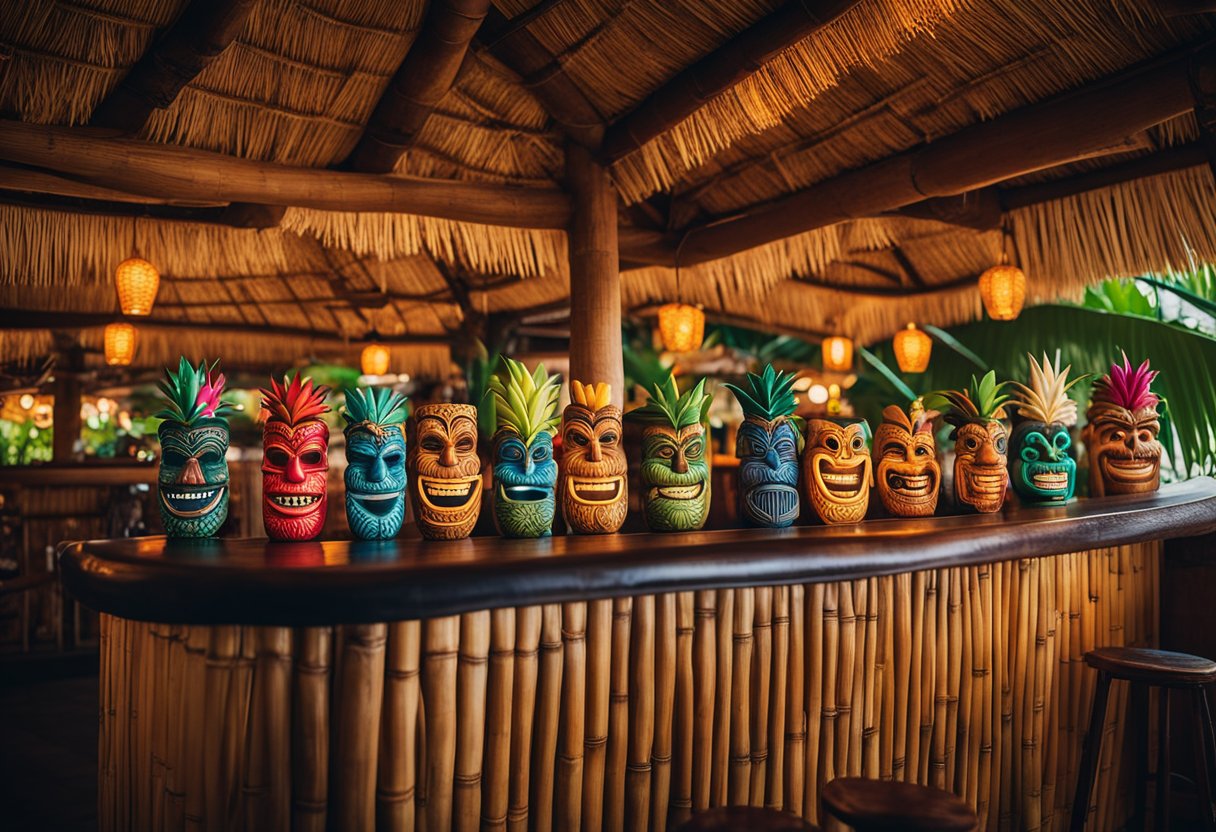
In this section, we’ll explore the hallmark drinks and food pairings that are intrinsic to the Tiki bar experience, focusing specifically on the innovative cocktails that define the genre and the Cantonese cuisine that often accompanies them.
Innovative Tiki Cocktails
Tiki bars are renowned for their array of exotic cocktails, with rum serving as the cornerstone for many of the genre’s classic drinks. The Mai Tai originated as an intricate concoction of lime, orgeat syrup, and rum, encapsulating the spirit of tropical escapism. Another firm favourite, the Zombie, is a potent blend which may include several types of rum, fruit juices, and liqueurs. Similarly, the Navy Grog, with its robust mix of rums, citrus, and honey, is a testament to the skill required to balance complex flavours in Tiki mixology.
- Mai Tai: Lime, Orgeat, Rum
- Zombie: Rum (various types), Fruit Juices, Liqueurs
- Navy Grog: Rum, Citrus, Honey
Culinary Pairings and Cantonese Cuisine
Alongside the cocktails, Tiki bars traditionally pair their alcoholic drinks with Cantonese cuisine, which complements the Caribbean vibe. The food offerings typically include a variety of appetisers and main courses that meld the aromatic spices and sweet-and-sour contrasts characteristic of Cantonese cooking. Such dishes create a harmonious match for the spiced and fruity profiles of Tiki beverages.
- Appetisers: Egg Rolls, Dim Sum
- Main Courses: Sweet and Sour Pork, Orange Chicken
These are the staples that have allowed Tiki culture to offer an immersive experience distinct from other bar styles, reflecting a blend of influences from the Caribbean and the Far East.
Cultural Impact and Spread
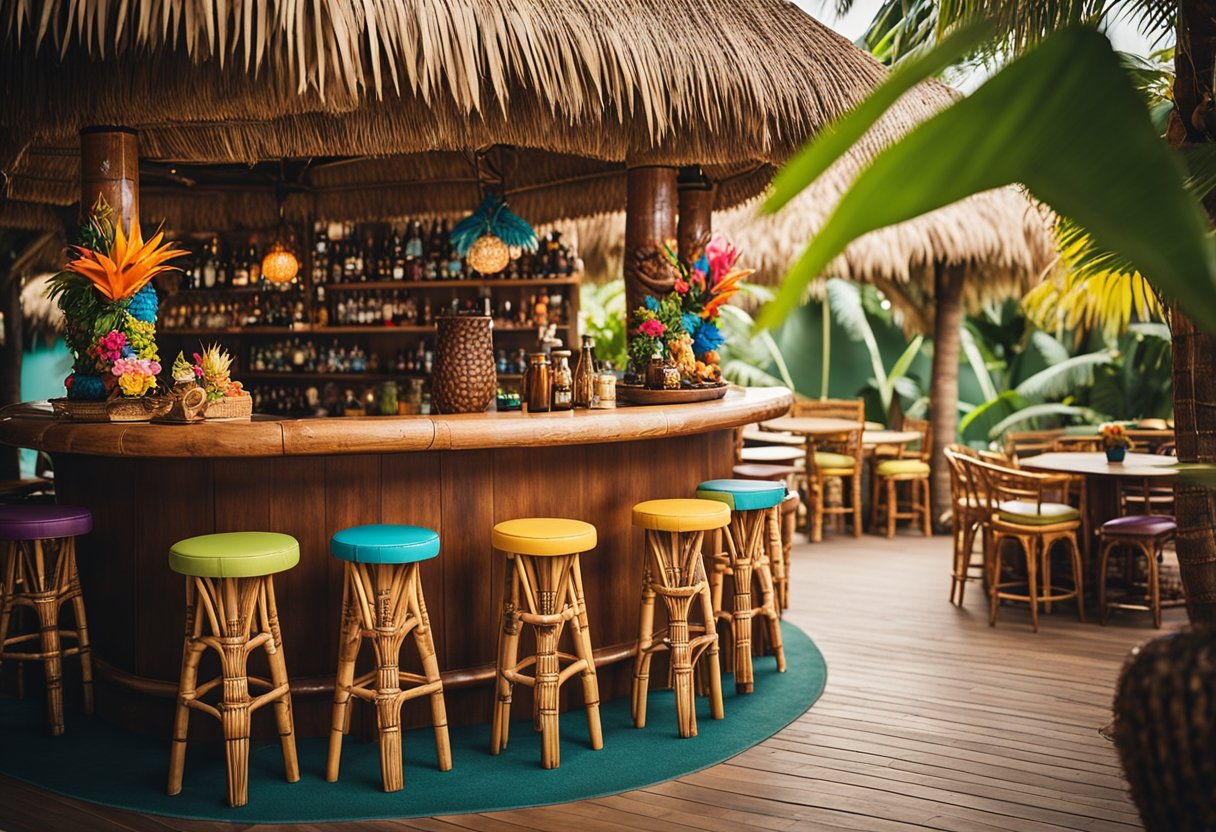
The Tiki phenomenon reshaped American entertainment and aesthetics, drawing on Polynesian motifs and sensory experiences. This cultural import had a profound effect on music, literature, and even home decor, weaving the exotic threads of the South Pacific into the fabric of American life.
Tiki’s Influence on Music and Literature
Tiki bars introduced America to the soothing and otherworldly sounds of exotica music, a genre that synthesised jazz with Polynesian, African, and Latin American rhythms. Artists like Martin Denny and Les Baxter were central figures, using novel instrumentation and animal noises to evoke tropical paradises. The sounds of exotica music captivated the American imagination, underscoring the fantasy of the Tiki bar experience.
On the literary front, authors were quick to capitalise on the Tiki craze. Works like Tales of the South Pacific by James A. Michener spurred the public’s interest in Polynesian culture, further popularising the motifs that Tiki bars used to attract patrons.
Expansion to Restaurants and Home Decor
Tiki culture extended beyond music and literature, profoundly influencing American dining and interior design. Numerous restaurants sought to replicate the successful Tiki formula, incorporating thatched roofs and tiki statues to set the scene for an exotic escapade right within city limits.
Home decor similarly saw a surge in Polynesian-inspired pieces, with bamboo furniture, tropical prints, and Tiki mugs becoming commonplace in American households. Our fascination with Tiki culture had turned a niche interest into a widespread domestic trend, reinforcing Tiki’s lasting influence on American society.
Issues of Appropriation
Tiki bars, an American invention symbolising tropical escapism, have been criticised for appropriating and misrepresenting Polynesian culture. This section explores the complexities of cultural appropriation within tiki culture, focusing specifically on concerns regarding cultural insensitivity and the evolving perspectives in modern times.
Critiques of Cultural Insensitivity
The concept of tiki bars has long faced criticism for its superficial and often inaccurate portrayal of Polynesian culture. Accusations of cultural appropriation arise from tiki culture’s use of exoticised and stereotypical imagery of the South Pacific. A New York Times article highlights how the Mai-Kai restaurant in Florida and others like it commodified Polynesian culture, serving alcoholic beverages like “Mystery Drinks” by women referred to as “Mystery Girls,” which reinforced objectifying and racist overtones.
These thematic establishments often neglect the rich history and significant cultural symbols of Polynesia, instead opting for an amalgam of tropical decor and iconography rooted in Western perceptions. This approach has been described as a form of exploitation, taking distinctive elements from Polynesian culture without due respect or accurate representation and turning them into decor and entertainment.
Modern Perspectives on Tiki Culture
In recent times, growing awareness and dialogue regarding cultural sensitivity have cast tiki bars in a different light. According to an article in Eater, both proprietors and patrons of modern tiki bars are reconsidering the cultural appropriation inherent in their foundations and its implications. This scrutinisation extends to the bar’s aesthetics and the origins of the tropical drinks they serve.
The discussion revolves around the significance of respecting and honouring the true essence of Polynesian culture rather than perpetuating stereotypes. There’s an effort from certain corners to reform tiki culture, shifting away from its problematic elements and making it more inclusive and mindful of its cultural impact.
Revival and Evolution
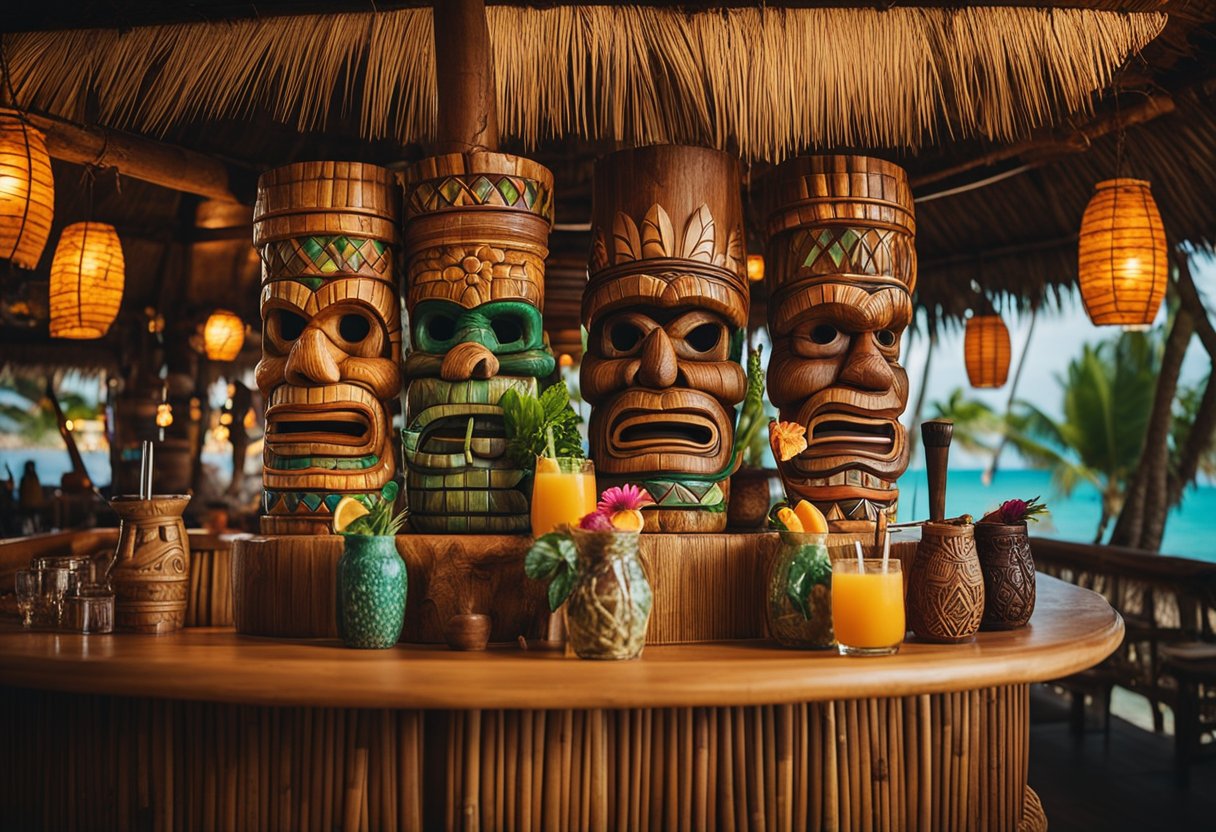
Tiki culture has seen a significant resurgence in the 21st century, with a new wave of enthusiasts and bar owners fostering a renaissance that pays homage to the past while innovating for modern tastes.
21st-Century Tiki Renaissance
With a profound nod to tradition, the 21st-century tiki renaissance honours the legacy of the mid-20th-century tiki pop phenomenon. Leading this revival are figures like Sven Kirsten, whose scholarly works have been pivotal in reigniting interest in Polynesian-inspired pop culture. Equally influential is Jeff “Beachbum” Berry, who has been instrumental in resurrecting classic tiki cocktails, often by unearthing and publishing once-lost recipes. This revival is marked not just by a rejuvenation of interest but a meticulous, almost studious respect for the history and craftsmanship of the original tiki era.
Contemporary Interpretations and Movements
Modern tiki bars combine a reverence for mid-century modernism with contemporary movements in mixology and decor. These establishments are not mere pastiches of the past but are spaces where the aesthetics and ethos of the tiki bar undergo a fresh evolution. Contemporary interpretations often feature a vibrant mix of classic decor with a new-age twist, echoing traditional tiki’s escapism while being attuned to today’s cultural awareness and inclusivity. Our quest for quality and authenticity has introduced a new generation to the allure of tiki culture, with renewed enthusiasm for not only the drinks but the immersive experience of the tiki bar itself.
Global and Regional Variations
As tiki culture has spread globally, regional variations have emerged, blending local traditions with the iconic elements of Polynesian pop.
Tiki Culture outside of America
Globally, the allure of the South Pacific has inspired various interpretations of tiki bars, each infusing a touch of local culture into the mix. In Europe, tiki bars often merge Polynesian aesthetics with regional flavours, offering a unique twist on the classic pineapple cocktails. Farther east, Asia’s take on the tiki bar frequently incorporates local ingredients and design motifs, creating a distinct version that pays homage to the original American concept while showcasing Asian influences.
Local Adaptations and the West Coast Scene
Within America, California has been a hub for the tiki scene ever since the inception of the tiki bar. The California tiki: a history of Polynesian idols, pineapple cocktails, and coconut palm trees, is rich and storied, heavily influencing the West Coast’s take on tiki culture. Here, establishments often combine local Californian flair with traditional tiki elements—a nod to the state’s history as a pioneer of the tiki movement. As enthusiasts and proprietors on the West Coast continue to innovate, the region’s tiki scene remains both a tribute to and a reinvention of classic Polynesian pop.
Prominent Tiki Bars and Resources
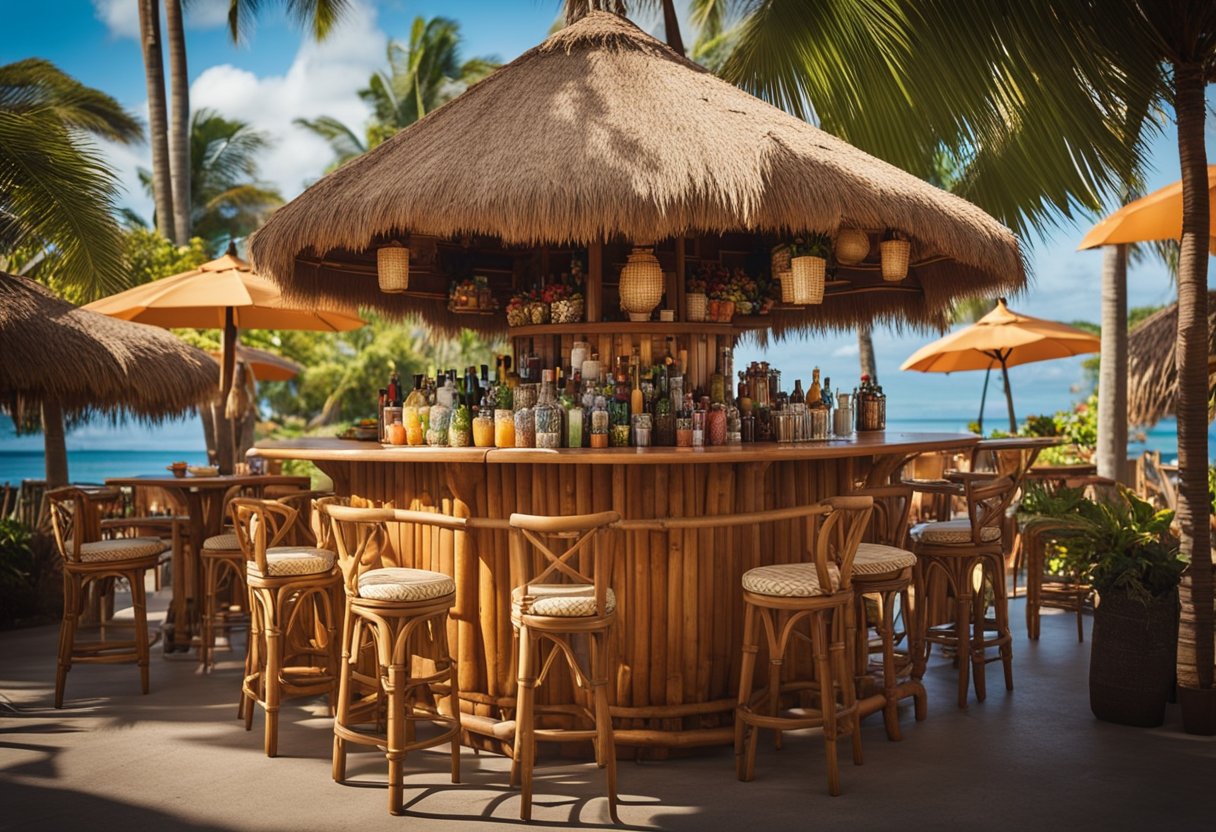
Exploring the influential tiki bars and insightful resources helps us uncover the charm and history of the Polynesian pop culture phenomenon in America. Here, we guide you through some of the most historic and iconic locations, as well as essential books, documentaries, and articles for enthusiasts.
Historical and Iconic Locations
- Trader Vic’s: A name synonymous with tiki culture, Trader Vic’s set the standard for Polynesian-themed bars. It began in Oakland, California and has since become a global phenomenon, enchanting visitors with its tropical ambience and signature cocktails like the original Mai Tai.
- Tiki Oasis: Located in San Diego, Tiki Oasis is the largest and longest-running festival in the world for lovers of Island culture—featuring music, art, education, and even mixology.
- Smuggler’s Cove: Nestled in San Francisco, Smuggler’s Cove offers an extensive rum selection and is renowned for its authentic decor and innovative tiki cocktails.
- Latitude 29: Situated in New Orleans, Latitude 29 combines the traditional tiki bar experience with a modern gastronomic twist created by the celebrated mixologist Jeff “Beachbum” Berry.
Books, Documentaries, and Articles
- Sven A. Kirsten: The author of Tiki Pop, Sven A. Kirsten, is acknowledged for his work documenting the tiki culture movement, providing a deep dive into its historical significance and revival.
- Taschen: Known for their lavish art books, Taschen published Sven Kirsten’s books, which have become seminal resources for understanding the aesthetic and cultural impact of the tiki style.
- MoMA: While not directly associated with tiki culture, MoMA has featured exhibitions and retrospectives that give context to mid-century modern design, of which tiki is a part.
Sustainability and Future Outlook
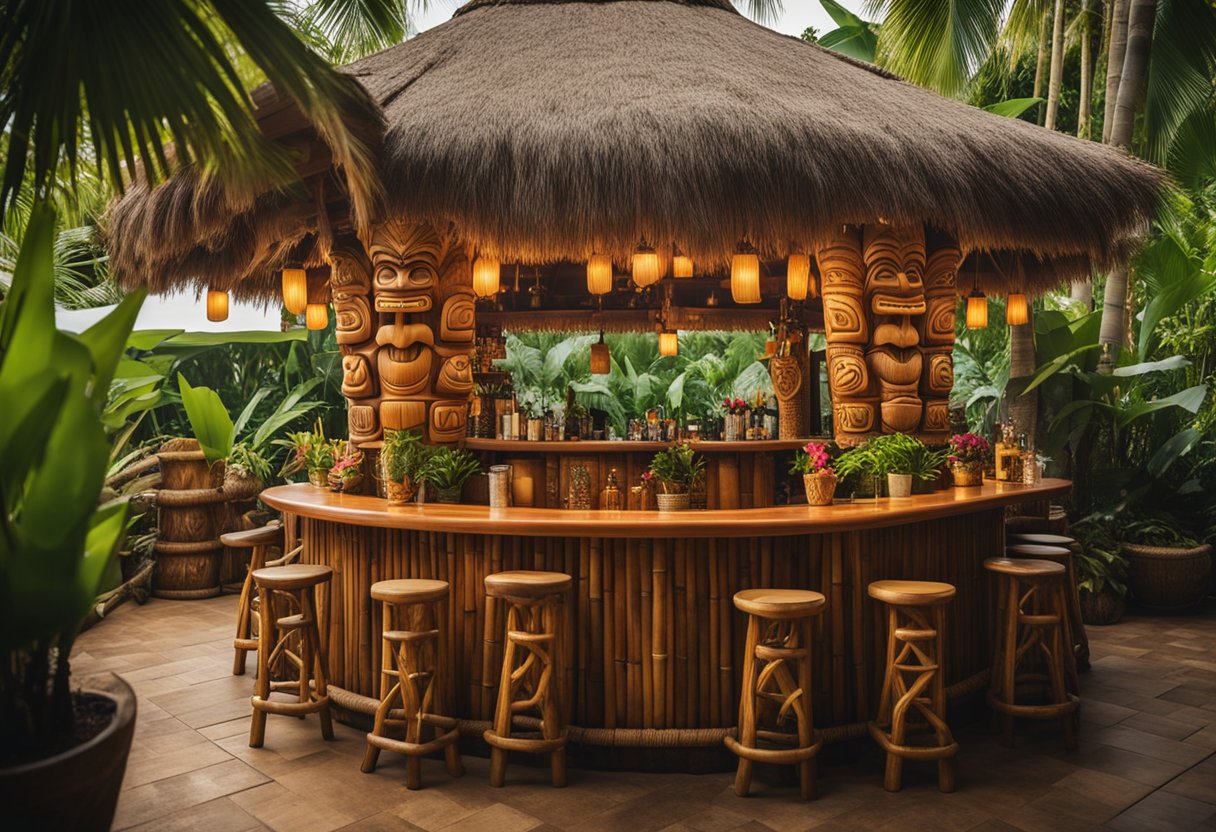
As the popularity of Tiki bars continues, it’s crucial to consider their impact on the environment and the conservation of Polynesian culture. We’ll discuss how Tiki bars adapt to the challenges of climate change and the ways they can honour and innovate upon Polynesian traditions.
Tiki Bars in the Age of Climate Change
Climate change poses a significant threat to our planet, and Tiki bars are no stranger to this challenge. With ingredients often sourced from tropical regions, it’s important that these establishments support sustainable practices to minimise their carbon footprint. This includes sourcing locally where possible, reducing waste, and utilising eco-friendly materials in their decor and construction. By doing so, Tiki bars can contribute to a more sustainable future, one that also helps preserve the environments of the Pacific Islanders whose culture they draw from.
Cultural Preservation and Innovation
Tiki bars have a unique opportunity to celebrate and preserve Polynesian culture while also innovating to reflect modern sensibilities. Honouring the ancestors and traditions of the Pacific Islands is essential, and this can be achieved by collaborating with Polynesian artists and cultural experts to create authentic experiences. This collaboration ensures that Tiki bars remain respectful and representative of the cultures they emulate. At the same time, they must innovate to stay relevant and engaging for the future. This could include reimagining traditional drinks and dishes with contemporary twists or using technology to create immersive environments without resorting to cultural stereotypes.
Frequently Asked Questions
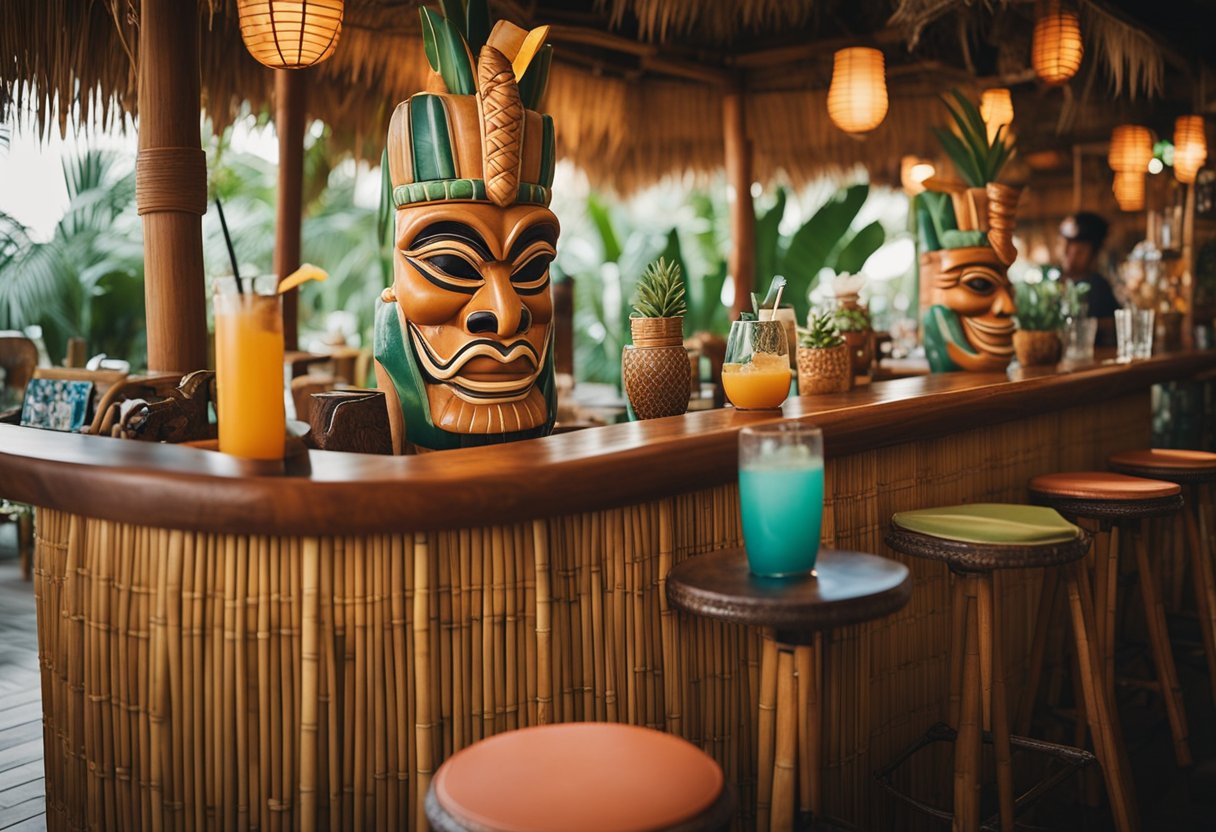
Within this section, we offer insights into the origins, influences, and contemporary discussions surrounding the American Tiki culture.
What is the history of Tiki culture within the United States?
Tiki culture began to captivate the United States in the mid-20th century, sparked by establishments such as Don the Beachcomber and Trader Vic’s. These venues introduced the mainland to Polynesian-inspired decor, exotic cocktails, and a unique escapism that captivated post-war America.
How has Tiki culture influenced American bars and restaurants?
Tiki culture has left a lasting imprint on American bars and restaurants, manifesting through tropical-themed decor, menus brimming with fruity cocktails, and an ambience of exotic fantasy. This theme aims to offer an immersive experience evoking the carefree and adventurous spirit of the South Pacific.
Why did Tiki bars gain popularity in America during the 20th century?
Tiki bars gained traction in America during the 20th century as they provided a whimsical escape from everyday life. In the post-war era, they embodied the allure of exotic travel and leisure which was then an emerging facet of the American Dream.
What is the cultural significance behind Tiki iconography and aesthetics?
Tiki iconography and aesthetics are deeply rooted in the art, mythology, and practices of Polynesian culture. The use of Tiki statues, masks, and motifs is a homage to these origins, often reflecting a stylised interpretation rather than historically accurate representations.
In what ways have Hawaiian bartenders reclaimed elements of Tiki culture?
Hawaiian bartenders are redefining Tiki culture by incorporating authentic elements, using indigenous ingredients, and educating patrons about the cultural significance behind traditional Hawaiian and broader Polynesian symbols and practices.
How is the concept of Tiki bars perceived in terms of cultural sensitivity and appropriation?
The concept of Tiki bars is scrutinised for issues of cultural sensitivity and appropriation, as it raises concerns about the commodification of Polynesian cultures. Debates encourage a dialogue on the balance between appreciation and appropriation and the importance of respecting the origins and people behind the culture.






